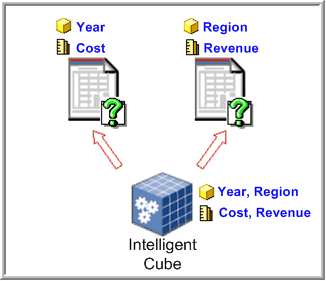MicroStrategy ONE
Run-time reporting with prompts
In addition to including base attributes, metrics, and other objects to be displayed on your reports, you can also determine how much of the report to display at run time. Prompts allow users to choose which objects and filtering criteria to apply to a report during report execution.
Prompts serve the same purpose in any report, including reports that connect to Intelligent Cubes. However, instead of modifying SQL at report run time, prompts allow reports to select data within the Intelligent Cube, as illustrated below.

The image above shows standard run-time reporting with prompts, while using OLAP Services to execute against the Intelligent Cube rather than against the data warehouse. The performance of your business intelligence application is improved by reducing execution against your data warehouse and maintaining only a single Intelligent Cube for multiple prompted reports.
Prompts on reports that connect to Intelligent Cubes can only access data that is available within the Intelligent Cube. These restrictions are applied automatically when creating prompts. For example, the attributes Year and Region and the metrics Cost and Revenue are included in the Intelligent Cube shown in the image above. If you create an object prompt in your report that connects to this Intelligent Cube, then you can only create prompts based on one of Year, Region, Cost, and Revenue.
You cannot use prompts that include objects or data that are not part of the Intelligent Cube, or prompts that use hierarchies. If you try to use such prompts, an error message is displayed.
Prompts in reports that access Intelligent Cubes can use the complete ROLAP schema of a project. However, if a prompt retrieves data from outside the Intelligent Cube, re-execution against the data warehouse is necessary.
